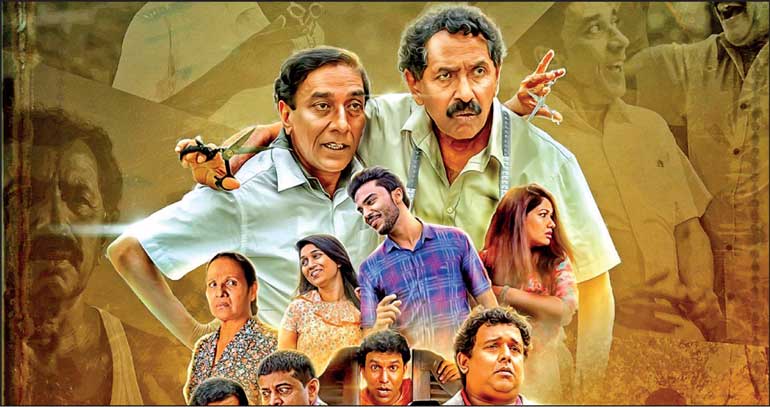Saturday Apr 19, 2025
Saturday Apr 19, 2025
Tuesday, 9 April 2024 00:20 - - {{hitsCtrl.values.hits}}

Through the lens of Wilson’s and Samson’s families, the movie inspires to embrace change, foster innovation, honour traditions, and discover new pathways towards success and fulfilment
 Overview
Overview
The renowned actor and director, Giriraj Kaushalya’s latest Sinhala film emerged as a remarkable hit, captivating audiences with irresistible humour. Produced by Basuru Siriwardena for Alankulama films, the movie features popular veteran actors, late Jayalath Manoratne, Mahendra Perera, Rodney Warnakula, Priyantha Seneviratne, Giriraj Kaushalya, Sampath Jayaweera, Gihan Fernando, Maureen Charuni, Jayani Senanayake, Sahan Ranwala, Piyumi Botheju, Ranga Jayakody, alongside the debut performances of Rasanjana Nandasiri and Sandani Hettigoda.
The movie emerges as a beacon of joy, spreading smiles and laughter. As it continues to charm audiences and win hearts, it cements its place as a must-watch cinematic gem in the vibrant landscape of Sri Lankan cinema.
The movie is centred on a tailor and a barber named Wilson and Samson who have been longstanding friends, both operating their business out of the same location. The mutual tool of “scissor” being the bread and butter of the mango friends, is emphasised in the title of the movie, “Katuru Mithuru”. Driven by the dreams of their parents and societal expectations, the children of the two friends enter the university and embark on a journey of higher education with hopes of securing promising career prospects. However, upon the completion of higher education, the son and the daughter of Wilson and Samson find it challenging to seek employment opportunities. The movie well addresses the contemporary belief of society, “study well and find a good employment opportunity” which is usually inculcated in the minds of children.
Going against this grain, the son and the daughter express their interests in walking down their fathers’ footsteps creating huge disappointment in the eyes of the parents. The two young adults eventually succeed in their careers after much convincing, having reopened the business venture that follow the same entrepreneurial pathways but meet contemporary needs.
Family business leadership perspective
Continuing the family business legacy across generations may take different facets based on the factors such as, owners’ perceptions, second generations’ perceptions, level of education and size of the enterprise. While succession planning often takes centre stage in well-established family-owned firms, it is a topic seldom brought into the discussion in the realm of small businesses, which is quite the highlight of the movie, Kathuru Mithuru.
In this backdrop, the article intends to bring some scholarly perspective to this discussion, emphasising on the 4-L framework of family business leadership laid down by Barret and Moor (2009). The framework encompasses four stages in pursuing family business leadership namely, learning business, learning our business, learning to lead our business and learning to let go our business.
Application
The movie, Kathuru Mithuru could be looked at from this theoretical lens of four learning phases of family business leadership. The offsprings of Wilson and Samson initially undergo formal education and successfully complete their degree programs. With the aim of joining their fathers’ businesses, the duo follows respective courses: fashion designing in lieu of tailoring and beauty culture in lieu of barbering. Such initiative helps them both in pursuing new knowledge and techniques in their respective fields. The movie also highlights how well the son and daughter performed in their courses as if the talent runs through the veins.
Subsequently, they start working for other organisations in related industries to get real-world experience and gain more practical understanding of the industry. ‘Going outside’ to gain professional insights and ‘return inside’ is deemed vital under this framework as it enables the next generation leaders to think differently and bring in new perspectives. This whole learning is captured under the first phase of ‘Learning business’.
The second phase of the 4-L framework is devoted to ‘Learning our business’. Having obtained required theoretical knowledge and practical exposure, it is vital for the second generation to return to the business and obtain organisational specific learning. Focusing on values, culture and practices revolving around the family business are crucial elements that new leaders must prioritise. While the film may not delve extensively into this phase, it highlights the loyal set of customer base over generations and the importance of safeguarding such values cannot be overlooked. Hence, the responsibility lies with the new generation to uphold such values ensuring the continuity of trust that the business has cultivated over the years.
Thirdly, ‘Learning to lead our business’ is the phase where offsprings join the business and take up the baton of leadership. Katuru Mithuru well pictures how the next generation re-opens the entrepreneurial ventures with modernity and modesty, taking the family business legacy forward. This phase requires the new leaders to professionalise the business while retaining the trustworthy culture.
The final phase, ‘Learning to let go our business’, is pointed towards the predecessors in managing their exit point from the family business. The movie well addresses this by showcasing how Wilson and Samson step aside from their ventures. It is indeed praiseworthy how such a movie filled with humour and laughter could bring the audience to an emotional state during the latter part. Accordingly, the movie put emphasis on the deep emotional impact on Wilson and Samson as they witness their business ventures undergo a complete turnaround at the hands of the second generation. This is quite a reminder that ‘Learning to let go our business’ is easier said than done. Nonetheless, this is also crucial in the family business context in avoiding potential conflicts between the two generations. Having said that, the older generation’s retirement plan may take a while depending on the nature and the scale of the business and readiness of the next generation. However, this phase would ultimately help clear line of succession with older generation perhaps playing an advisory role.
Reflection on lessons learned
The film indeed brought laughter to the audience and marks another important milestone in Sinhala cinema. Going beyond humour, the message that Kathuru Mithuru passes to the community is indeed timely and commendable. Fostering entrepreneurship is pivotal to a nation and the movie even addresses this from a family business perspective. This also stands as an eye-opener for inculcating entrepreneurial mindsets, moving from “being employed” to “being the employer”. Through the lens of Wilson’s and Samson’s families, the movie inspires to embrace change, foster innovation, honour traditions, and discover new pathways towards success and fulfilment.
Reference:
Barret, M., & Moores, K. (2009). Spotlights and shadows: Preliminary findings about the experiences of women in family business leadership roles. Journal of Management & Organization, 15(3), 363-377.
(The writer is Senior Lecturer, Department of Management and Finance, Faculty of Management, Social Sciences and Humanities, General Sir John Kotelawala Defence University.)
Discover Kapruka, the leading online shopping platform in Sri Lanka, where you can conveniently send Gifts and Flowers to your loved ones for any event including Valentine ’s Day. Explore a wide range of popular Shopping Categories on Kapruka, including Toys, Groceries, Electronics, Birthday Cakes, Fruits, Chocolates, Flower Bouquets, Clothing, Watches, Lingerie, Gift Sets and Jewellery. Also if you’re interested in selling with Kapruka, Partner Central by Kapruka is the best solution to start with. Moreover, through Kapruka Global Shop, you can also enjoy the convenience of purchasing products from renowned platforms like Amazon and eBay and have them delivered to Sri Lanka.
Discover Kapruka, the leading online shopping platform in Sri Lanka, where you can conveniently send Gifts and Flowers to your loved ones for any event including Valentine ’s Day. Explore a wide range of popular Shopping Categories on Kapruka, including Toys, Groceries, Electronics, Birthday Cakes, Fruits, Chocolates, Flower Bouquets, Clothing, Watches, Lingerie, Gift Sets and Jewellery. Also if you’re interested in selling with Kapruka, Partner Central by Kapruka is the best solution to start with. Moreover, through Kapruka Global Shop, you can also enjoy the convenience of purchasing products from renowned platforms like Amazon and eBay and have them delivered to Sri Lanka.